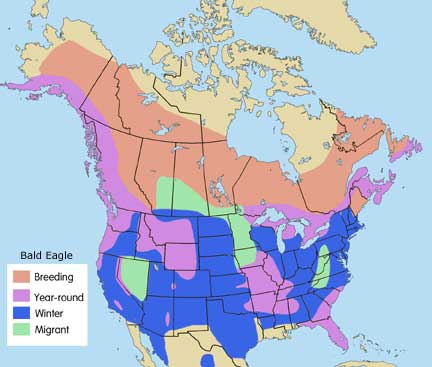
Scientific Name: Haliaeetus leucocephalus
This majestic bird of prey, our national symbol, has a distinctive adult color scheme – white head, white tail, dark brown body, yellow eyes, and a massive yellow beak. As with many other raptors, the female is larger than the male and the sexes look alike. It takes four years for immature birds to develop the characteristic adult plumage pattern, so identifying young birds can be confusing. Juveniles resemble Golden Eagles in being generally brown, but they lack the golden head, and their legs are only feathered halfway to the foot. Immature birds of both species are brown with areas of white; young Golden Eagles have areas of white on the tail and the bast of the flight feathers, while young Bald Eagles show more variable patterns of white speckling. The Bald Eagle has a relatively large head, and long, straight-edged wings; young birds have broader wings and longer tails than adults. This eagle flies with slow, shallow, powerful wing beats, and soars with wings held out flat.
Males and females
Length: 27 – 35″
Wingspan: 71 – 89″
Weight: 4.4 – 13.6 lbs
State and federally protected, both under the Migratory Bird Treaty Act and the Bald and Golden Eagle Act; previously listed as endangered and then threatened under the Endangered Species Act, Bald Eagle populations have recovered sufficiently for their delisting.
Wherever there is a good fishing and foraging – near rivers, lakes and seacoasts. They can also be seen in other areas during times of migration, following mountain ridges to catch thermal updrafts. In their wintering areas, they often form large communal night roosts.
These eagles primarily eat fish and waterfowl, but they are opportunistic foragers, and will eat a variety of food. Dead fish, carrion, and some mammals form part of their diet. Piracy is a favored technique also – letting other birds such as Osprey catch fish, then taking the meal away from them. They often hunt flocks of ducks or geese by herding them, then selecting one bird to tail-chase. Hunting from a perch is also common.
Eagles are quite vocal around each other, giving soft kak kak kak kak sounds when chattering together, as well as various chirping whistles. Juveniles tend to have harsher, more shrill calls. Although usually quiet in flight, they will sometimes give a kya…kya…kya…
Build large stick nests in the broken tops of old-growth trees, or on rock outcrops – usually with a waterfront view. A pair will return to the same nest year after year, lining it with greenery and building it up to giant proportions. Bald Eagles sometime put on dramatic displays of whirling, talon-locking aerial combat and courtship during breeding season.
Birds with an eagle-sized wingspan are at great risk of electrocution on powerlines. Other common injuries include collisions with vehicles and power lines, poisonings, and gunshot wounds.

Found in North America from central Alaska and Canada south to Baja and northern Mexico; southern populations are depleted . Most leave the inland northern breeding grounds to form winter concentrations, especially along areas like the Chilkat River in Alaska, the Klamath Basin in Oregon, and the upper Mississippi River valley.
Special thanks for the range maps
Dan Gleason
BGleason Design & Illustration
Commercial & Scientific Illustration, Graphic Design
CraneDance Communications
Book Production/Design

